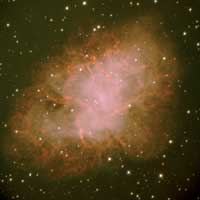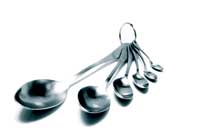The neutron teaspoon Inspire article
Jonathan Swinton pushes back the frontiers of knowledge – in his kitchen.

rotating neutron star
Image courtesy of ESO
It is well known that a teaspoonful of neutron star is really quite heavyw1. This would provide a way to estimate the density of a neutron star, in units of ‘really quite heavy’ per millilitre, were the volume of the teaspoon known in millilitres. We report the surprising results of a series of determinations here.
Literature review
Estimates of the volume of a teaspoon vary from 1.5 ml (NASAw2) to 5 ml (author’s spouse). However, both sources have been known to be in error: the Hubble Space Telescope for the former, and an unpublished occasion for the latter.
Materials
All identifiable teaspoons were gathered from two locations (author’s dishwasher and cutlery drawer, including the rarely seen spot right at the back with the pastry crimper) containing teaspoons believed not to have been previously used to unscrew things.

These comprised: in shiny metallic (steel), five wedding-list teaspoons, acquired at time of marriage to teaspoon expert, with subsequent resupply at time of critical inability to find any teaspoons at all in this bloody house (Lim et al., 2005), two Ikea teaspoons, two unbranded spoons (made in China), and two Winnie the Pooh spoons (superior E. H. Shepard version); in plastic, three spoons from technical suppliers (Teletubbies, Mothercare, and Heinz Baby Basics), and the measuring spoon from the breadmaker. A 5 ml medicine spoon was used as a positive control.
Methods
Preliminary studies revealed surprising differences between the volume in a level teaspoon and a heaped teaspoon. Assessment of level loading was subject to parallax errors when evaluated from the height of the 6-year-old technical assistant, although these were minimised by the beginning of The Simpsons and the subsequent author-only experiments. Assessment of maximum loads was performed by watching for the first drip, and required a steadier hand than likely available. Replications were not performed so as not to complicate the analysis of variance.
Results
Plastic teaspoons were found to be consistently smaller level loaders than steel spoons and were discarded from subsequent analysis on the grounds that no one visualises a Teletubbies spoon full of neutron star. The plastic spoons did have heaped loads comparable with the metal spoons, possibly because of increased surface tension. The 11 steel teaspoons had a mean level volume of 2.66 ml (standard deviation 0.37 ml) and heaped volume of 4.2 ml (standard deviation 0.46 ml). Intriguingly, the positive control had a level load of only 3.2 ml and was reclassified as a vacillating control.
Conclusions
- Teaspoons do contain about 5 ml, but only when you heap them.
- Although NASA is wrong and author’s spouse may appear to be right, power effects mean that acknowledgement of this from such a small sample size is unlikely.
- Water in surface tension looks rather beautiful close up.
- Where’s the rest of the breadmaker?
References
- Lim MS, Hellard ME, Aitken CK (2005) The case of the disappearing teaspoons: longitudinal cohort study of the displacement of teaspoons in an Australian research institute. British Medical Journal 331: 1498-1500. DOI: 10.1136/bmj.331.7531.1498
Web References
- w1 – The Wow of Physics: The Amazing Variability of the Neutron Star Teaspoon
- w2 – A Teaspoon of Starstuff





